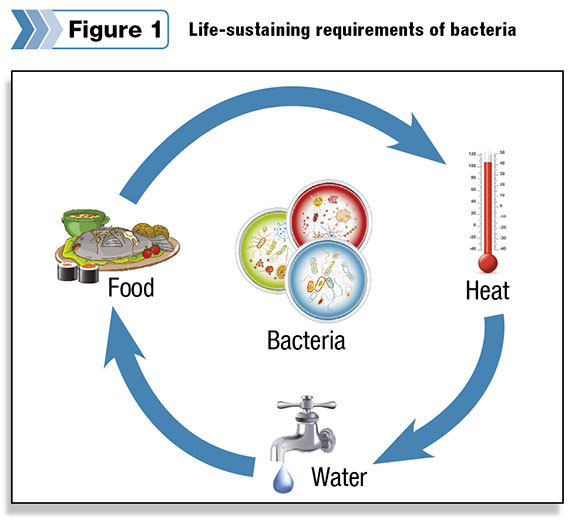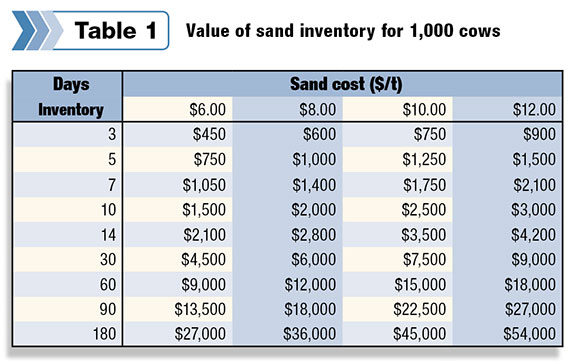Question: What is the purpose of freestall bedding? Answer: To provide a cow a clean, dry resting surface. Especially, this means creating an environment where exposure of teat ends to attack from mastitis-causing pathogens is minimized. Veterinarians and your family doctor alike will tell you: Minimize exposure to minimize infection rates.
With manure bedding maintaining producer interest for the sake of perceived manure-handling shortcuts, plus the introduction in recent years of sand recycling systems used in conjunction with cross-ventilated barns employing evaporative cooling, now more than ever is a time to understand the role of bedding – clean, dry bedding.
Here we will discuss experiences with recycled sand bedding quality. In some facets, there are more questions than answers.

Food, heat and water
For the purpose of this discussion, the life cycle of bacteria can be broken down as follows ( Figure 1 ): Bacteria need three things to survive – food, heat and water. Think of this in terms of the cow-to-bedding interaction.
First, the food. In a freestall environment, this means residual manure from the separation process.
Next you have heat, which comes from the ambient environment as well as the resting cow herself. Last, we have water.
This can be in the form of splashed urine, leaked milk, cooling water or simply ambient moisture.
Take any one of these away – food, heat or water – and you greatly diminish the ability of mastitis-causing organisms to survive.
Perhaps you can see why sand bedding has proved successful from a cow health standpoint: It is free from organic matter, it tends to remain cool and liquids percolate from the stall surface.
The detriment of organic matter in bedding is twofold. Not only is it a food source for bacteria, but it is also a means to water insofar as organic matter particles are like tiny sponges.
Recyclability criteria
What makes recycled sand bedding acceptable for reuse with lactating cows? Of course, new sand must be free of stones, debris and organic matter often found in unprocessed sand. A study was conducted during the 1970s attempting to link coliform bacterial population in bedding to mastitis infection.
The study concluded when colony-forming units (CFU) of coliform bacteria exceeded one million per gram of wet bedding, there was an increased incidence of mastitis.
Although this study consisted of a very small sample of cows in sawdust bedding pack, one million CFU per gram has become recognized to some extent as being the upper threshold for coliform bacteria in bedding, in general.
As some mammary gland physiologists state, this is the “million cell myth.” Nevertheless, we do know one thing, as noted above: Reduce exposure to reduce infection. So, regardless, bacterial activity in sand should be minimized. How do we do this?
It starts with doing a good job of sand-manure separation in the first place. Recall the needs of bacteria: food, heat and water. If we remove the food, we also remove the water, which both go a long way toward thwarting bacterial growth. But there’s more to recycled sand than coliform count.
When sand mixes with organic matter, the result is essentially dirt, and dirt packs. Compaction occurs simply due to the pressure a cow’s body applies to a stall base. Packing usually becomes evident when stalls are hard and mounds of sand develop under each freestall loop.
This is an indication sand has become dirt, and as such, has lost its ability to flow freely (a key to cow comfort), not from a bacteriological standpoint but instead the mechanical aspects of cows rising, laying and resting.
An unpublished survey of 250 freestalls across 25 farms was conducted by Michigan State University, the goal being to subjectively relate sand freestall condition and producer preference to sand organic matter content.
The study showed that from a producer preference standpoint – that is, the stalls which appeared most suitable to cows (i.e. clean, soft, dry, etc.) – the organic matter content was 2 percent or less on a dry basis.
Far from definitive, this serves as merely a guide when judging recycled sand quality. But again, from what we know about what causes bacteria to thrive and survive, reducing organic matter reduces both the food and water available to mastitis-causing pathogens.
Sand conditioning and inventory
Assuming a sand separation process removes the maximum amount of organic matter, the next question is: How can we get the sand cleaner and drier? Keep in mind, due to water adhesion to sand grains, there are limits to how physically dry sand can be without drying via evaporation (like grain drying).
That figure is somewhere in the neighborhood of 10 percent moisture. Typically, sand conditioning is done using time, labor and equipment, or any combination thereof. Time plays a significant role in conditioning of sand as it allows for organic matter (hopefully present in small quantities) to degrade and some liquids to leach away.

The disadvantage of time alone is the potential to tie up cash in the form of large sand stock piles – inventory.
The value of sand inventory can be seen in Table 1 for 1,000 cows assuming sand usage of 50 pounds per cow per day at varying sand costs.
For instance, at $10 per ton, storing sand for 90 days results in sand inventory worth $22,500.
Mechanical conditioning is achieved by repeatedly moving and windrowing sand using payloaders. Typically, the tops (driest part) of sand piles are removed and placed in one pile to be reused more quickly than, say, the pile bottoms, which tend to contain more organic matter and moisture.
Producer experiences indicate smaller piles are more successful than large piles for conditioning sand, as smaller piles have more surface area and a shorter distance through which water drains.
There is no evident literature relating time and pile size to sand reusability. All we know is, the longer the better. Remember though, “longer” comes at a cost.
Dewatering screens, as used in the mining industry, can be used to dewater recycled sand. Dewatering screens can reduce moisture content 40 percent (20 percent to 12 percent) and organic matter 88 percent (1.5 to 0.2 percent).
These devices function by forming a bed of dewatered sand on a vibrating screen deck. Water adhering to sand particles is literally shaken free. Liquids then filter through the sand bed. In some cases, sand use is immediate.
Do a good job of separation first
Judging recyclability of bedding sand is usually done literally through the eye of the beholder. Basic biology suggests mastitis-causing bacteria require food, heat and water to survive. Start by implementing sand-manure separation that removes maximum amounts of organic matter – remove organic matter and you remove both food and water.
Mechanical sand conditioning either by repetitive piling or by dewatering equipment helps to reduce the time from when sand is separated to the time it goes back to freestalls. Consequently, sand inventory is reduced and money is saved. Consider testing sand for organic matter content and shoot for less than 2 percent organics.
Testing for organic matter is an inexpensive and common analysis performed by soils labs. Attempting to reduce sand bacterial content below a threshold of perhaps questionable origin could be fraught with expense and frustration.
Furthermore, the analysis is expensive with results highly dependent on sample handling. Also, the analytical basis varies across labs. Some present results in terms of CFU per gram of dry bedding, some CFU per gram of bedding and some in CFU per ml of bedding.
Suffice it to say, the population of mastitis-causing organisms in bedding sand should be kept to a minimum. To do so, start by attacking organic matter. PD
Wedel is an agricultural engineering P.E. with McLanahan Corporation in Hollidaysburg, Pennsylvania, specializing in sand-laden manure handling, separation, and treatment systems that focus on cow comfort.

Andrew Wedel
Division Manager/Agricultural Engineer
McLanahan Corporation
.jpg?t=1687979285&width=640)




